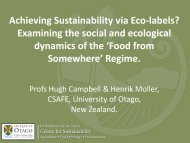Book of Abstract (incl. addendum) - IFSA symposium 2012
Book of Abstract (incl. addendum) - IFSA symposium 2012
Book of Abstract (incl. addendum) - IFSA symposium 2012
Create successful ePaper yourself
Turn your PDF publications into a flip-book with our unique Google optimized e-Paper software.
Workshop 1.3 Understanding agricultural structural changes and their impacts, to support<br />
<strong>incl</strong>usive policy dialogue and formulation<br />
Collective actions and the dynamic <strong>of</strong> agrifood system from the perspective<br />
<strong>of</strong> the Romanian small vegetable producers<br />
Cornelia Alboiu<br />
Institute <strong>of</strong> Agricultural Economics, Romania<br />
Coraalboiu@yahoo.com<br />
The integration into the world trade and particularly along the chain <strong>of</strong> products with high value added,<br />
such as the vegetables chain, is considered as a promoter <strong>of</strong> growth and poverty alleviation (Aksoy and<br />
Beghin, 2005), even though this topic is subject to controversy. The paper’s purpose is to assess the<br />
role <strong>of</strong> collective actions in farmers’ participation in the Romanian supply chains, more exactly the<br />
possibility <strong>of</strong> farmers to adapt to the dynamic retail chains using new institutional economic theories.<br />
Having given the requirements imposed by retail chains to vegetable suppliers in terms <strong>of</strong> quantity,<br />
quality, frequency, food safety, it is expected that a small farmer cannot afford to participate<br />
individually in the retail chains due to high transaction costs, lack <strong>of</strong> scale and institutional changes<br />
required. In order to see the determinants <strong>of</strong> joining collective actions by farmers, binary logit/probit<br />
models were used. The results signal out a small degree <strong>of</strong> farmers’ participation in collective actions.<br />
Also, they reveal a certain degree <strong>of</strong> uncertainty among stakeholders in terms <strong>of</strong> institutional<br />
arrangements and participation in collective action.<br />
Animal production systems in Algeria: transformation and tendencies in the<br />
Sétif area<br />
K. Abbas<br />
INRA, Algeria<br />
Abbaskhal@yahoo.fr<br />
In spite <strong>of</strong> its large area (2.4 million km2), Algeria has only 8 million ha <strong>of</strong> UAA, <strong>of</strong> which only 443<br />
000 ha are irrigated (0.05%). With a population <strong>of</strong> more than 30 million inhabitants, the country<br />
registers 0.25 ha per capita, which represents a very low ratio. Agriculture is concentrated in a narrow<br />
fringe concentrated in the North, where the dominant climate is semi-arid with very irregular rainfalls.<br />
In the South, a steppe area <strong>of</strong> more than 30 million ha is mainly devoted to small ruminants'<br />
production. A majority <strong>of</strong> farms produces its main part <strong>of</strong> income from cereal crops–livestock<br />
association system. However, the diversity <strong>of</strong> the climate and the physical environment, on one hand,<br />
and the agricultural policies on the other hand, induce major transformations in these systems.<br />
Transformations are also the result <strong>of</strong> a significant demographic growth in rural area. This fact is<br />
translated by an increase in food needs. In this context, significant issues appear in term <strong>of</strong> resource’s<br />
uses and systems’ sustainability. To shed light in the actual situation, this study, based on a survey <strong>of</strong><br />
90 owners, shows that: - the intensification can constitute a threat on the pastoral resources; - the<br />
weakness <strong>of</strong> the farms encourages the generalization <strong>of</strong> practices characterized by a weak feed<br />
autonomy and a bad management <strong>of</strong> stock fodders; - the animal interspecific integration and partial<br />
intensification are positive if they follow models which ensure autonomy, performance and optimal<br />
pastoral resource management.<br />
29











